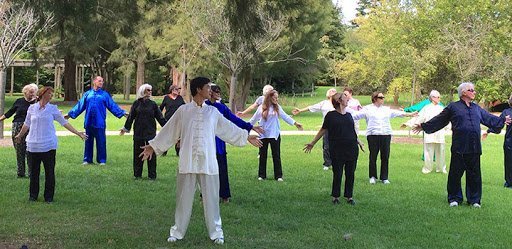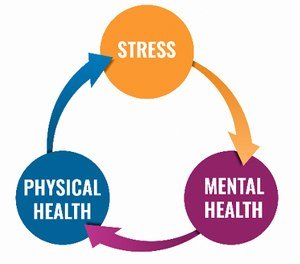Understanding Qigong
Most people know that deep breathing calms the nervous system, but they do not know how much more potent that becomes when coordinated breath is combined with slow, rhythmic full-body movement. The combination tends to double the effect. Qigong is an excellent way to reduce your stress and anxiety.
You need a great deal of mindfulness to practice Qigong, which makes this exercise a relaxing and effective way of reducing stress and increasing energy. Even more than that, though, Qigong has been effective in reducing many mental health symptoms and physical illnesses.
There is no one-size-fits all when it comes to Qigong. People use Qigong for many different purposes—to heal from physical illness or reduce depression or anxiety. The style of movement takes on different forms depending on the specific goal of the user.
Qigong for stress relief
Research has shown that Qigong directly impacts anxiety, depression, stress, mood and self-esteem. In randomized controlled trials, anxiety decreased significantly for the participants who practiced Qigong compared to an active exercise group. Studies have also shown that people who practice Qigong reduced their depression symptoms significantly more than those who did not participate.
In another study, Qigong decreased levels of circulating cortisol – which indicate stress — in participants who practiced Qigong, compared to a wait-list control group.
Qi Gong is the art of working with your internal energy to improve your state of being. Quite literally, “Qi” means “internal energy,” and “Gong” means “to work with.” In all of Lee’s classes, he focuses on teaching students nourishing practices for personal empowerment and wellbeing.
One of the most common reasons people start to practice Qi Gong is to overcome stress. Not only does it feel unpleasant to be stressed out or anxious, but it also is harmful for your health.
Although Qi Gong is a highly effective way to deal with stress, it is certainly not the only method. In fact, every action or behaviour throughout your day has an impact on the energy within your body. Essentially, all of life is Qi Gong.
While we recognize that Qi Gong can be a way of life, for those who are not yet ready to incorporate it into their daily living routines, if practiced regularly it can certainly help with your stress and anxiety. Therefore, I decided to share five simple stress management techniques that you can use in your everyday life to let go of anxious energy and return to a place of composure and groundedness.
Understanding Stress
Before diving into techniques for managing stress, it is important to understand the nature of this unpleasant energy.
Stress is your experience of your nervous system reacting to something that is perceived as threatening. At its strongest point, stress is your “fight or flight” mechanism that helps keep you safe when your life is in danger.
There are times when this nervous system response is healthy and important. Back when humans were hunter-gatherers, this ability of the body helped people to stay safe and protect themselves against animals or attackers. Even today, there are still instances in which your sympathetic nervous system (fight or flight) can save your life.
There are other times when your sympathetic nervous system is activated but your life is not in danger. In fact, in the twenty-first century, it is exceedingly rare that you actually need to get stressed out in order to stay alive. Most of the time, your body is simply overreacting based on its evolutionary programming.
The important thing to emphasize is that stress is a response in your body. From your body, it moves into your mind and emotions, where it transforms into anxious thinking and uncomfortable feelings.
Now that we have established what stress is and where it comes from, let us talk about how to overcome it.
Step 1: Notice:
It is important to become sensitive of when you are feeling stressed. Sometimes, it can be difficult to pause and notice these things when you are in the midst of a busy day and have a lot on your plate. However, if you do not bring your awareness to your state of being, you are going to be powerless to do anything about it.
Just like how in Qi Gong you work with your mind in order to become aware of the energy in your body, you must learn how to do the same when you are not in a dedicated Qi Gong practice.
If you find it difficult to notice when you are feeling stressed, perhaps try to put a sticky note on your desk, computer, or other place where stress often comes up for you. This will help to remind you to check in with yourself and realize what is true for you.
Step 2: Label:
Once you have stopped and noticed that something does not feel quite right, try to label your experience. Perhaps say to yourself, “I am feeling stress in my body,” or “My mind is experiencing anxious thoughts.”
By putting a label on your feelings, you are able to create a separation between yourself and your experience. Instead of being the feeling, you are now viewing it as something distinct from yourself that can be transformed. This makes it easier to accept and work with.
While this process is highly effective for managing stress, it is also a great way to identify all feelings that you may experience. When you realize that you have been emotionally activated, noticing and labelling your feelings is a powerful step towards moving through them and returning to harmony. Anger, sadness, frustration, and stress are all experiences that can be labelled and worked with.
Step 3: Do Something Physical:
I mentioned earlier that stress is a physical response to your environment. That means it is something that is experienced within your body and not just your mind or emotions. Therefore, it is important to recognize that you cannot “think” your way out of a stressful state. Your brain may be useful for thinking through math problems, but stress cannot be solved in the same way.
When you are feeling stress, it is a good idea to take a break from whatever you are doing and move your body. Exercising, doing Qi Gong, or taking a brisk walk are great options. By moving your body, you are able to cycle through your nervous system’s sympathetic response and return to a more grounded state.
It can often take between fifteen and thirty minutes for your body to calm down and start to relax, depending on your level of stress. If you find your mind starts to wander during your movement activities, just try to notice and bring it back to the present moment. Seek to be aware of your physical sensations and work with the energy in your body rather than focus on your thoughts.
Step 4: Take Slow, Deep Breaths:
After spending fifteen to thirty minutes moving your body, it is time for some slow, deep breathing. Stand or sit in a comfortable, upright position and start to inhale through your nose and exhale through your mouth. It can be helpful to place one hand on your lower abdomen and the other on your chest so you can feel your lungs expand and contract with each breath.
On your inhale, breathe in through your nose, bringing fresh, nourishing energy into your body. On your exhale, release the air out through your mouth as you let go of any stress or anxiety. Do not be afraid to make a loud, audible sound on your exhale as you visualize yourself letting go of anything you do not want. For many people, this comes out as an “aaaaahhhhh” sound.
Taking slow, deep breaths is a wonderful way to continue letting go of stress and cultivating the energetic state that you wish you experience. Try to bring you attention and awareness to each breath in order to enjoy each moment as fully as possible.
Step 5: Reorient and Set an Intention:
Once you feel that you’ve cleared most of the stagnant energy from your mind and body, it’s time to reorient and set an intention for the experiences that lay before you. Even if you have some challenging tasks ahead, you always have a choice about how you want to feel as you go through your day.
Now that you have cleared stress and become aware of how you feel, you are in a great position to find a new way of navigating through the world. Instead of allowing your mind to be in a reactive state, you can set an intention to embrace the day with inspiration and optimism.
To do this, imagine the feelings and mindset that you want to experience moving forward. At this point, do not think too much about what you have to do, but rather, focus on how you want to feel. Envision yourself composed, confident, and ready for what the world has to offer. Continue breathing as that vision grows within your heart and mind.
After focussing on the feelings you want to experience, start to imagine yourself going about your day and accomplishing your goals. Instead of focussing on the problems that previously caused you stress, try to imagine yourself finding solutions. A positive and confident outlook can go a long way in helping you succeed in whatever you are doing.
These simple techniques are a great way to turn your day around whenever you notice that stress and anxiety is getting the best of you. Sometimes, all it takes is realizing your emotions and dedicating thirty minutes to shifting your energy. Even if you cannot immediately change your environment, there are usually ways you can improve your experience of your environment.
Simple Qigong exercises for stress and anxiety

Warm-Up Exercises (5 to 10 min.)
Qigong Exercise One: Gentle Sway
1. For five minutes, move both of your arms from your shoulders in a gentle swinging motion. The motion itself is initiated from your waist: Twist from the waist as though your torso were a washcloth that you were wringing out. Do not twist from the knees or you may harm them. Furthermore, twisting from the waist provides a massage to the internal organs and provides you the full benefits of the exercise.
2. To get started, move your arms side to side across your torso, and then back to front.
3. Keep your knees slightly bent. Let your hips sway. Allow your mind to clear. At first, focus on the release of unnecessary and unconscious stress. After several weeks, you may shift your focus so that you think only about the swaying of your arms and the motion of Qi energy.
Qigong Exercise Two: The Bounce
In the beginning, try this for one to three minutes.
1. With your feet parallel and about shoulder’s width apart, bounce with your knees loose and your arms hanging at the sides like a wet noodle. They should feel empty and neutral. This is the zero position for your arms. When you are bouncing back and forth, your arms in zero should get a nice jiggling effect.
2. Keep your shoulders natural; neither pull them back or let them slump forward too much. When the zero position is used on the whole body, you should receive a feeling of deep relaxation and your internal organs and skin should hang down. This process brings awareness of internal tension so that you can do something to dispel it, if you choose.
The combination of exercises one and two gently massages and tonifies the Organ Systems, which helps promote longevity.
Qigong Exercise Three: Accordion
In this, you feel the Qi energy by using your hands like the bellow of an accordion or a bicycle pump.
1. Close your eyes halfway. Clear your mind and concentrate your attention on your palms.
2. Allow your breath to become slow, easy, without force. In a way, you are creating the very lightest trance.
3. Bring your hands together, palms touching and fingers pointing upward. The palm chakras, called Laogong, located in the centre of the palms, should be touching. These chakras are areas where Qi can be felt emanating from the body.
4. Slowly move your hands, keeping the centre of your hands towards each other. When they are about 12 inches (30 cm) apart, slowly move them together using the least amount of physical effort possible. Breathe out when you pull your hands apart, breathe in when you close them together.
5. You will be compressing the air between them like an accordion would.
6. Feel a warm or tingling sensation at the Laogong points on your palms.
7. Move your hands slowly back and forth, varying the range of the bellows. Repeat the accordion technique in different directions: horizontally, vertically, and diagonally.
This exercise cultivates Qi, builds awareness, and sensitizes yourself. When you feel Qi energy for the first time, it changes your mind-set.

Try these 3 exercises and see how you feel afterwards. Practiced on a regular basis they will be very powerful in reducing your stress and anxiety and can lower your blood pressure.
If you combine Qigong with the fantastic methods I use in my coaching plans then you have a really powerful way of lowering your stress and coping with your anxiety.
The combination of all of these really does work. Together they’ll help you get back to doing the things you love with your friends and family. You’ll likely see an improvement in your work performance too.
As with any form of exercise, even this gentle one, if you have any health concerns please take medical advice before trying them.
I would love to know how you get on, and if you have any questions, I am happy to chat through it with you. Just send me a message and let’s chat.







